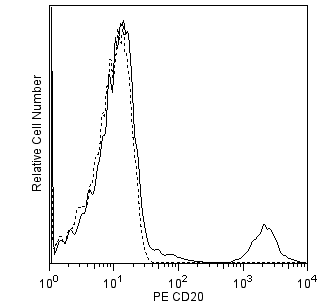-
Your selected country is
Middle East / Africa
- Change country/language
Old Browser
This page has been recently translated and is available in French now.
Looks like you're visiting us from {countryName}.
Would you like to stay on the current country site or be switched to your country?




Two-color flow cytometric analysis of mTOR (pS2448) expression in stimulated human peripheral blood B cells. Human peripheral blood mononuclear cells (PBMC) were either not stimulated (dashed line histogram) or stimulated (solid line histogram) with Type C CpG oligonucleotide (1 μM, 4 hrs; InvivoGen, Cat. No. TLRL-2395). The cells were fixed with BD Cytofix™ Fixation Buffer (Cat. No. 554655; 10 minutes at 37°C) and then permeabilized by adding BD Phosflow™ Perm Buffer III (Cat. No. 558050; 30 minutes on ice). The cells were washed twice with BD Pharmingen™ Stain Buffer (Cat. No. 554656) and then stained with BD Phosflow™ Alexa Fluor® 647 Mouse Anti-mTOR (pS2448) (Cat. No. 564242) and BD Phosflow™ PE Mouse Anti-Human CD20 (Cat. No. 561174) antibodies using the BD Biosciences Protocol for Intracellular Staining. The fluorescence histograms were derived from CD20 positive-gated events with the forward and side light-scatter characteristics of intact lymphocytes. Flow cytometric analysis was performed using a BD LSRFortessa™ Cell Analyzer System.


BD Phosflow™ Alexa Fluor® 647 Mouse Anti-mTOR (pS2448)

Regulatory Status Legend
Any use of products other than the permitted use without the express written authorization of Becton, Dickinson and Company is strictly prohibited.
Preparation And Storage
Product Notices
- This reagent has been pre-diluted for use at the recommended Volume per Test. We typically use 1 × 10^6 cells in a 100-µl experimental sample (a test).
- An isotype control should be used at the same concentration as the antibody of interest.
- Caution: Sodium azide yields highly toxic hydrazoic acid under acidic conditions. Dilute azide compounds in running water before discarding to avoid accumulation of potentially explosive deposits in plumbing.
- Source of all serum proteins is from USDA inspected abattoirs located in the United States.
- The Alexa Fluor®, Pacific Blue™, and Cascade Blue® dye antibody conjugates in this product are sold under license from Molecular Probes, Inc. for research use only, excluding use in combination with microarrays, or as analyte specific reagents. The Alexa Fluor® dyes (except for Alexa Fluor® 430), Pacific Blue™ dye, and Cascade Blue® dye are covered by pending and issued patents.
- Alexa Fluor® is a registered trademark of Molecular Probes, Inc., Eugene, OR.
- Alexa Fluor® 647 fluorochrome emission is collected at the same instrument settings as for allophycocyanin (APC).
- For fluorochrome spectra and suitable instrument settings, please refer to our Multicolor Flow Cytometry web page at www.bdbiosciences.com/colors.
- Please refer to www.bdbiosciences.com/us/s/resources for technical protocols.
Companion Products




The O21-404 monoclonal antibody recognizes the human mammalian target of rapmycin,(mTOR) that is phosphorylated at
serine residue 2448, mTOR (pS2448). mTOR belongs to the phosphoinositide-3-kinase (PI3K)-related (PIKK) family of kinases. mTOR is also known as mechanistic target of rapamycin (serine/threonine kinase), FRAP, RAFT1, and RAPT1. mTOR functions as an amino acid and ATP sensor to balance nutrient availability and cell growth. When nutrients are sufficiently available, mTOR is activated by phosphorylation at serine residue 2448 through the PI3 kinase/Akt signaling pathway. Phosphorylated mTOR in turn activates the p70 S6 kinase and contributes to the inactivation 4E-BP1, an elF4E inhibitor. In this way, mTOR participates in the upregulation of cellular protein synthesis, growth, proliferation and survival. mTOR function may be abnormally regulated in tumors.
Development References (6)
-
Brown EJ, Albers MW, Shin TB, et al. A mammalian protein targeted by G1-arresting rapamycin-receptor complex. Nature. 1994; 369(6483):756-758. (Biology). View Reference
-
Chiu MI, Katz H, Berlin V. RAPT1, a mammalian homolog of yeast Tor, interacts with the FKBP12/rapamycin complex. Proc Natl Acad Sci U S A. 1994; 91(26):12574-12578. (Biology). View Reference
-
Holz MK, Blenis J. Identification of S6 kinase 1 as a novel mammalian target of rapamycin (mTOR)-phosphorylating kinase. J Biol Chem. 2005; 280(28):26089-26093. (Biology). View Reference
-
Johnson SC, Rabinovitch PS, Kaeberlein M. mTOR is a key modulator of ageing and age-related disease. Nature. 2013; 493(7432):338-345. (Biology). View Reference
-
Nave BT, Ouwens M, Withers DJ, Alessi DR, Shepherd PR. Mammalian target of rapamycin is a direct target for protein kinase B: identification of a convergence point for opposing effects of insulin and amino-acid deficiency on protein translation. Biochem J. 1999; 344:427-431. (Biology). View Reference
-
Sengupta S, Peterson TR, Sabatini DM. Regulation of the mTOR complex 1 pathway by nutrients, growth factors, and stress. Mol Cell. 2010; 40(2):310-322. (Biology). View Reference
Please refer to Support Documents for Quality Certificates
Global - Refer to manufacturer's instructions for use and related User Manuals and Technical data sheets before using this products as described
Comparisons, where applicable, are made against older BD Technology, manual methods or are general performance claims. Comparisons are not made against non-BD technologies, unless otherwise noted.
For Research Use Only. Not for use in diagnostic or therapeutic procedures.
Report a Site Issue
This form is intended to help us improve our website experience. For other support, please visit our Contact Us page.